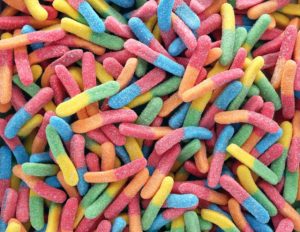
Worst Halloween Candy for Your Teeth
Most kids look forward to trick or treating throughout the year. In fact, dressing up and heading out on Halloween night is a fun activity for people of all ages. Especially if they have a sweet tooth!
Of course, you want your patients to have fun this Halloween. The best way to help them is to educate them on avoiding certain cavity-causing candies.
During this time of year, many patients ask their dentists, “what is the worst candy for your teeth?”. Check out this list of the worst Halloween candies to help you educate your patients.
Taffy & Sticky Candies
Photo by Jonathan J. Castellon on Unsplash
Popular types of sticky candy include candy corn, Starburst, gummy bears, and Skittles. Let’s not forget taffy! These candies are thick and tacky. Their sticky texture causes them to become stuck in the teeth, requiring a bit of effort to remove.
The sugar inside these sticky candies feeds harmful bacteria. If the candy is not removed from the surface of the teeth, the bacteria begin to multiply at a furious rate. In turn, the patient will face an increased risk of cavities.
Taffy can also pull an existing filling, dental crown, or dental bridge right out of its place. This leaves the tooth even further exposed, potentially leading to more restorative treatment. It’s no wonder taffy is a strong contender for the worst candy for Halloween!
Caramel
Caramel is a strong contender for one of the worst candies for your teeth. Some examples of caramel candies include Caramel apples, Snickers, Twix, and caramel chews. They are certainly all rich and delicious but are best avoided if you want to protect your teeth.
Like other sticky candies, caramel rests in the crevices of the teeth. Caramel’s high sugar content puts your teeth at significant risk of developing decay. Like taffy, caramel can also potentially dislodge existing fillings, crowns, or bridges.
Jawbreakers
Photo by Bill Nino on Unsplash
The concept of a jawbreaker is to leave a large piece of candy inside the mouth until it begins to dissolve. As it shrinks, it reveals brightly colored layers towards the center.
As previously discussed, long-term exposure to sugar significantly increases the risk of cavities. The longer a piece of candy stays inside the mouth, the more acidic the oral environment becomes. This can wreak havoc on the teeth.
Jawbreakers are also extremely hard; their name is well-earned! Biting down on a jawbreaker once it has dissolved and become smaller can crack or break the teeth. They can even cause damage to the jaw. This can lead to the need for various types of serious restorative treatment.
Gummy Candies
Gummy candies fall under the category of “sticky” candies.
Gummy bears, gummy worms, peach rings, and the like can be tasty and fun to eat. Yet, the consequences may make you think twice about popping them in your mouth.
Like other sticky candies, gummies can adhere to the teeth and become stuck in the crevices. This leads to a serious risk of cavities if they are not quickly and thoroughly cleaned from the teeth.
Sour Candy
Photo by Yes and Studio on Unsplash
Sour candies like Sour Skittles, Warheads, Sour Patch Kids, and Lemon Drops are all acidic.
Acids break down tooth enamel, increasing the risk of cavities as the enamel wears away. The high sugar content in sour candies can then cause a “double attack” on the weakened tooth enamel.
Hard Candy & Lollipops
Photo by Iwona Castiello d’Antonio on Unsplash
Lollipops, Jolly Ranchers, and Butterscotch are all popular hard candies. They’re often seen in Halloween candy buckets around the country each year.
These types of candies are designed to suck on over long periods of time. Keep in mind that the longer a candy remains inside the mouth, the more dangerous it becomes.
High sugar and acid levels in hard candies attack teeth weakening the enamel resulting in damage to the inner layers of teeth.
Those who are too impatient to suck on a piece of hard candy over a long period of time will bite down and chew. This can break the tooth and/or existing restorations. Ouch!
Popcorn Balls
Popcorn may be a “healthy” treat, but it tends to get stuck in the teeth. Popcorn balls are bunches of popcorn dipped in caramel, marshmallows, or sugary glaze to form their shape.
This sticky coating can be damaging to teeth. Once the glaze hardens, it becomes quite hard and can cause damage to the teeth when biting into the sweet treat. Bits of sugary popcorn become stuck in the teeth, increasing the risk of cavities.
After Halloween Care
Halloween comes but once each year! It’s almost impossible to discourage excited little ones from trick or treating. Yet, you can give your patients valuable advice for making the right choices. Educate patients on the best and worst Halloween candies. Take the time to explain why these candies are harmful to the teeth.
Inform your patients of the importance of thoroughly brushing and flossing their teeth immediately after finishing Halloween candy. This is the best way for them to keep their tooth enamel healthy, even if they’ve had a bit of “bad” Halloween candy.
When it comes time to treat your patients, Safco Dental Supply is here for you. We are proud to provide the dental tools and supplies you need.
Click here to browse our extensive inventory of dental supplies.
For more information about our products or for help with your order, feel free to give us a call at 800.621.2178.




